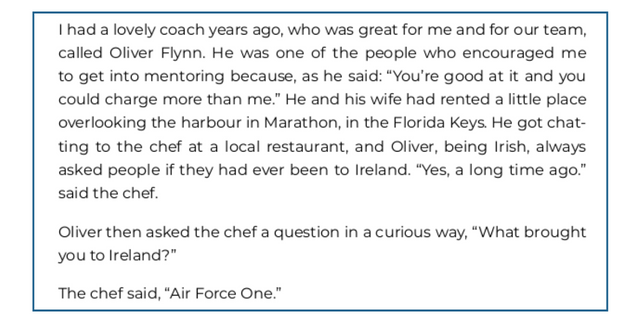“The true essence of communication lies not in speaking, but in being heard and understood.”
– Piers Fallowfield-Cooper
In a world brimming with diverse cultures, languages and traditions, the potential for miscommunication is as common as a handshake (or a bow) in a business meeting. It’s not just about the words we choose; it’s about the messages we send – often through tone and body language as much as the words themselves, plus the meanings we attach, and the meanings others extract.
When Yawning isn’t Just Tiredness
JoJo, a friend of mine from Bali, provided a perfect anecdote. In Sydney, during a casual gathering, as the evening progressed, he was caught in a yawn. “Are you tired?” someone asked. His response was simple yet profound, “No, just sleepy.” At first glance, this could seem like a typical exchange. But it’s not. It’s a prime example of how we project our interpretations onto others. For JoJo, where English is a learnt, second language, there is a difference between being tired (fatigued) and sleepy (ready for bed).
In “The Stuff of Thought” by Steven Pinker, he delves into how language reflects human nature and our social interactions. Pinker explores how words can convey different meanings based on context, culture and the cognitive frameworks of the speaker and listener. If the Inuit people (allegedly) have a hundred words for snow and the nomads of the steppes of Asia multiple words for the quality and style of an animal’s coat, the ‘wonder words’ in British English are quite and nice. Small tonal shifts and changes of inflection can produce multiple meanings from disappointment to pleasantly surprised.
For JoJo, yawning was merely a physical response of soon it will be bedtime.
When Gifts are not Just Gifts
When I was travelling around the world for business, I always consulted, “Kiss, Bow, or Shake Hands1“. It gave me a quick view of business customs in whatever country I was visiting. It covers how to greet people, talk in meetings and even what gifts to give in over 60 countries. It’s simple and straight to the point, helping you avoid an inadvertent insult. Great for people who want to make a good impression and avoid stepping on cultural toes. Perfect for keeping your business manners sharp and respectful, wherever you go.
Did you know there’s a good number and a bad number of golf balls to buy when you’re giving a gift in Japan? It’s a nuanced example of how cultural practices can influence even the simplest of gestures. In Japanese business culture, the presentation of a gift, like a set of golf balls, is often tied to symbolism and intention. The number of golf balls can carry different meanings, influenced by cultural beliefs and traditions around numbers. Such details are important in Japanese culture, where business practices often intertwine with social customs and attention to detail is highly valued. If you are interested, no packs of 4 or 9 balls – and, whatever gift you do give, it must be beautifully wrapped!
But you don’t have to travel far or visit an alien country to get confused, just pop along to the theatre.
When Shouting in a Theatre isn’t only for the Cast
Most people when asked, would happily agree that shouting by audience members in a theatre is an antisocial and inappropriate thing to do. They are quite right; it is a bad thing to do until the context changes. If the theatre is on fire, maybe we would be very pleased to hear shouts from the stalls. In such scenarios, the initially perceived rudeness transforms into a public service, alerting others to imminent danger.
Change the context everything changes.
I would also add that if the show is “The Rocky Horror Picture Show”, “Mama Mia!” or a traditional Christmas Panto then high levels of shoutin’, misbehavin’ and singing along are not only allowed but encouraged, blending the lines between the cast and spectators, creating a communal experience that defies conventional behaviour.
When Cheese and Biscuits aren’t just Cheese and Biscuits
Simple misunderstandings can come much closer to home. When facilitating group activities around communication skills (or, more often, miscommunication skills), I sometimes used a game I created called ‘Cheese and Biscuits’. Participants would write down what cheese and biscuits meant to them and what they would expect to be served. As we discuss around the table, the concept expands. Cheddar and brie were always popular, then someone would throw in blue cheese. Then crackers (digestives, no Ryvita) and grapes would appear, another might suggest a
slate or a wooden board for serving. Gradually, more items like quince jam, celery and walnuts are proposed. This exercise demonstrates how a simple concept like ‘cheese and biscuits’ can have numerous interpretations, each variation based on individual perspectives, highlighting both the diversity in thought and expectations within a group but more importantly the danger of projection: if it means this to me, it must mean this to you as well.
When Direct Flights aren’t Exactly Direct
Language, in its essence, is both an art and a science. It’s a tool for expression and a mechanism for understanding. However, the same words can carry different weights in different contexts. Consider the term ‘direct flight’. When travelling in the United States, to the uninitiated, ‘direct flight’ implies a non-stop journey. However, in U.S. aviation parlance, a ‘direct flight’ may well make a pit stop in Chicago, St Luis, or another airline ‘hub’. It’s a subtle difference, but for the international traveller, it’s a lesson learned in the skies.
The quality of our questions and our use of generative language determine our world. One of the key reasons that humans as a species (in addition to the long opposable thumb) took over the world was that as well as language being a practical communication tool, we also use language generatively – this idea that ‘words create worlds’.
When President Kennedy said: “I believe that this nation should commit itself to achieving the goal, before this decade is out, of landing a man on the moon and returning him safely to the Earth.” He created a new possibility.
Here’s an excerpt from my book: Are You Still The Future?

He had been Jack Kennedy’s personal chef.
A standard question, such as “where did you go?” would have received a predictable answer, for example, “I went to Dublin”. This particularly Irish way of questioning opened up a surprising avenue of conversation and revealed much more interesting information.
When Regular isn’t All That Frequent
This duality of language extends beyond idiomatic expressions. On my first trip to ‘Middle Earth’ I decided to get as much variety as possible, staying in various accommodations in New Zealand, from luxurious lodges to homely B&Bs, I engaged in numerous conversations with friendly locals. In one memorable instance, whilst staying on the beautiful west coast of the South Island, I was asked would I consider living in New Zealand. I said that I thought the country was beautiful and its people welcoming but also mentioned my passion for music, art and theatre – commodities I felt were a bit scarce in the region. My host, quick to defend her homeland, pointed out the regular visits of the New Zealand Symphony Orchestra to Christchurch: “We drive across to see them.” Yet, on closer inspection, ‘regular’ was a relative term; their next performance was scheduled months away. Regular it may have been, frequent it wasn’t.
And, on the subject of time, ‘presently’ doesn’t quite mean the same thing to a Brit as it does to an American.
In British English, ‘presently’ typically means ‘soon’ or ‘in a little while’. It implies that something will happen in the near future but is not happening immediately. On the other hand, in American English, ‘presently’ often means ‘currently’, ‘at the moment’ or ‘my next thing to do’. This difference in usage can sometimes lead to confusion, as the American usage suggests something is already happening, whereas the British usage indicates it will happen but has not started yet. This distinction is a subtle yet fascinating example of how the same word can evolve different meanings in different English-speaking cultures.
When quantity doesn’t improve the quality
Whilst speaking about words that superficially have similar meanings, any TV or Streaming service viewer has probably noticed that the number of options available i.e. quantity of channels does not necessarily equate to variety.
Subtle word switches can have a profound difference in impact. In South Africa, the electricity supplier uses a technically correct term ‘load shedding’ when they cannot meet power demand. ‘Rolling power cuts’ which is what the end user experiences, seems to have much more edge to it. ‘Global warming’ was downgraded to the much less threatening ‘climate change’ through intensive lobbying from powerful US interests.
As a humorous aside, traffic lights in South Africa are called ‘robots’, as in: “turn right at the robot”.
When a Bank isn’t just Local
The HSBC “Your Point of View” campaign ran prominently around the world in the mid-2000s, you might recall their billboards and series of adverts that aimed to celebrate differing perspectives and cultures around the world, encapsulating HSBC’s self-styled position as ‘The world’s local bank.’
The campaign cleverly used simple images juxtaposed with opposing viewpoints to highlight the diversity of opinions, beliefs and values globally. Here are a few examples.



The campaign underlined the importance of understanding and respecting cultural differences in global communication. By acknowledging that perspectives vary widely across cultures, HSBC positioned itself as a bank that listens, understands, and caters to the diverse needs of its global customer base.
The adverts were often simple, featuring minimal text alongside powerful images so they could be easily understood by a broad audience, demonstrating that sometimes less is indeed more in communication. They engaged people emotionally by touching on subjects close to our hearts and daily lives. The campaign showed that understanding and integrating into local cultures doesn’t dilute a global brand; rather, it can enhance its appeal.
It’s a brilliant strategy for communication-engaging your audience in a way that makes them reflect on their own positions and consider others’.
When Listening is More than Hearing
The art of miscommunication is not just about misunderstanding; it’s also about not understanding that ‘the words’ are just the tip of the iceberg in the vast ocean of human interaction.
So, how do we navigate this labyrinth of linguistic nuances?
- The first step is awareness. Recognising that words carry different meanings in different cultures or situations is essential.
- Secondly, question assumptions. A simple inquiry can unveil the true intent behind a statement.
- Thirdly, embrace the diversity of interpretation. It adds colour to our conversations and depth to our understanding.
- Finally, remember, context changes everything.
Mastering the subtle art of communication, great communicators excel by acknowledging the profound impact of context, tone, body language and cultural differences on understanding. They adeptly navigate the intricate dance between what is said and what is heard, transforming potential misunderstandings into opportunities for deeper connection. By valuing the nuances of human interaction and prioritising empathy and active listening, they turn the art of communication into a tool for building bridges, ensuring that the true essence of communication is not just in speaking, but in being truly heard and understood.
Piers in Your Pocket:
Remember, next time you find yourself puzzled by a conversation or lost in translation, think about the context: remain open and curious, take a moment to consider the cultural and linguistic backdrop of your interlocutor. Remember in this global village, (which may be closer than you think) a little patience and a lot of curiosity go a long way. And as the great stand-up comedian George Carlin said: “Everyone smiles in the same language.”
“In the symphony of global dialogue,
every pause and inflection adds to the melody of understanding.”
Piers Fallowfield-Cooper
1 Kiss, Bow, Or Shake Hands: The Bestselling Guide to Doing Business in More Than 60 Countries, Terri Morrison and Wayne A. Conaway, first published in 1997 by Adams Media

/Amazon_(company)-Logo.wine.png)


